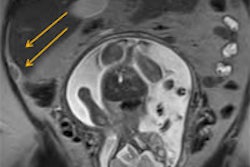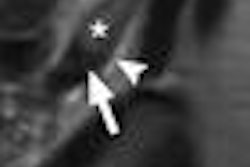Monday, November 29 | 3:00 p.m.-3:10 p.m. | SSE20-01 | Room N230
Dutch researchers have found that both MRI and diffusion-weighted imaging (DWI) MRI achieve high accuracy in diagnosing appendicitis in pediatric patients, with negative predictive value and positive predictive value of MRI comparable to CT.The prospective study, conducted at the Medical Center Alkmaar in Alkmaar, the Netherlands, enrolled 105 pediatric patients who were clinically suspected of acute appendicitis.
Fifty-eight female and 47 male patients with a mean age of 12.1 years underwent abdominal ultrasound, as well as a 1.5-tesla MRI scan, including DWI, within a maximum of two hours (mean time, 39 minutes). Follow-up included all available data for a period of at least three months.
A panel of two surgeons and one radiologist determined acute appendicitis through MRI in 58 (55%) of 105 patients. There were six false positives in the MRI results and a true negative in 41 cases. There were no false negatives. Therefore, sensitivity was 100%, specificity was 87%, positive predictive value was 91%, and negative predictive value was 100%.
Four of the six false-positive patients were operated on, with two normal appendixes at histopathology, one appendiceal carcinoid, and one ovulation bleeding. The other two false-positive patients were admitted and observed and, as symptoms disappeared, were diagnosed with nonspecific abdominal pain.
DWI revealed 57 true positives, six false positives, 40 true negatives, and one false negative. Sensitivity was 98%, specificity was 87%, positive predictive value was 90%, and negative predictive value was 98%.
The researchers also found that ultrasound was inconclusive in 45 cases (43%) -- of which MRI correctly diagnosed 43 cases (96%) -- and resulted in 11 true positives and 32 true negatives.
"The No. 1 benefit of MRI is the lack of exposure to radiation, which is, as we all know, especially important in children because of their exponentially higher lifetime cancer mortality risk attributable to radiation exposure," said radiologist Mai Thieme, MD, who will present the results at the RSNA meeting. "The second benefit is not only to use anatomical information, but also to evaluate the movement of water-proton molecules to indicate inflammation. The third benefit is to [produce] alternative diagnoses in areas where ultrasound and CT have problems in evaluating structures, such as soft tissues close together."
Thieme added that using MRI in an acute diagnosis, such as appendicitis, can challenge department logistics. "Both MRI equipment, as well as trained technicians, need to be flexibly available, preferably 24 hours a day," she said.
Since completion of the study, MRI has become the standard of care at Medical Center Alkmaar in pediatric and adolescent patients with an inconclusive ultrasound, Thieme said.
The facility also participated in a prospective multicenter study on MRI in acute appendicitis in adults, and it is currently evaluating the results of another study to determine the learning curve in reading MRI for acute abdominal symptoms.
"It is likely that we will continue our research in the field of MRI and acute abdomen, because it is a challenging subject," Thieme said.


.fFmgij6Hin.png?auto=compress%2Cformat&fit=crop&h=100&q=70&w=100)





.fFmgij6Hin.png?auto=compress%2Cformat&fit=crop&h=167&q=70&w=250)











